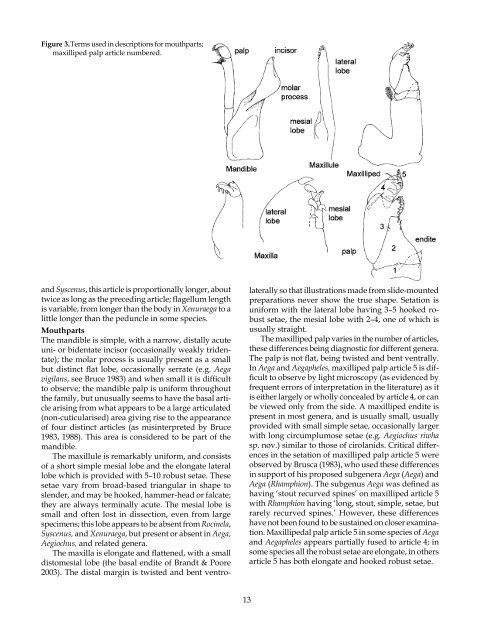The Marine Fauna of New Zealand: Isopoda, Aegidae (Crustacea)
The Marine Fauna of New Zealand: Isopoda, Aegidae (Crustacea)
The Marine Fauna of New Zealand: Isopoda, Aegidae (Crustacea)
Create successful ePaper yourself
Turn your PDF publications into a flip-book with our unique Google optimized e-Paper software.
Figure 3. Terms used in descriptions for mouthparts;<br />
maxilliped palp article numbered.<br />
and Syscenus, this article is proportionally longer, about<br />
twice as long as the preceding article; flagellum length<br />
is variable, from longer than the body in Xenuraega to a<br />
little longer than the peduncle in some species.<br />
mouthparts<br />
<strong>The</strong> mandible is simple, with a narrow, distally acute<br />
uni- or bidentate incisor (occasionally weakly tridentate);<br />
the molar process is usually present as a small<br />
but distinct flat lobe, occasionally serrate (e.g. Aega<br />
vigilans, see Bruce 1983) and when small it is difficult<br />
to observe; the mandible palp is uniform throughout<br />
the family, but unusually seems to have the basal article<br />
arising from what appears to be a large articulated<br />
(non-cuticularised) area giving rise to the appearance<br />
<strong>of</strong> four distinct articles (as misinterpreted by Bruce<br />
983, 988). This area is considered to be part <strong>of</strong> the<br />
mandible.<br />
<strong>The</strong> maxillule is remarkably uniform, and consists<br />
<strong>of</strong> a short simple mesial lobe and the elongate lateral<br />
lobe which is provided with 5– 0 robust setae. <strong>The</strong>se<br />
setae vary from broad-based triangular in shape to<br />
slender, and may be hooked, hammer-head or falcate;<br />
they are always terminally acute. <strong>The</strong> mesial lobe is<br />
small and <strong>of</strong>ten lost in dissection, even from large<br />
specimens; this lobe appears to be absent from Rocinela,<br />
Syscenus, and Xenuraega, but present or absent in Aega,<br />
Aegiochus, and related genera.<br />
<strong>The</strong> maxilla is elongate and flattened, with a small<br />
distomesial lobe (the basal endite <strong>of</strong> Brandt & Poore<br />
2003). <strong>The</strong> distal margin is twisted and bent ventro-<br />
laterally so that illustrations made from slide-mounted<br />
preparations never show the true shape. Setation is<br />
uniform with the lateral lobe having 3–5 hooked robust<br />
setae, the mesial lobe with 2–4, one <strong>of</strong> which is<br />
usually straight.<br />
<strong>The</strong> maxilliped palp varies in the number <strong>of</strong> articles,<br />
these differences being diagnostic for different genera.<br />
<strong>The</strong> palp is not flat, being twisted and bent ventrally.<br />
In Aega and Aegapheles, maxilliped palp article 5 is difficult<br />
to observe by light microscopy (as evidenced by<br />
frequent errors <strong>of</strong> interpretation in the literature) as it<br />
is either largely or wholly concealed by article 4, or can<br />
be viewed only from the side. A maxilliped endite is<br />
present in most genera, and is usually small, usually<br />
provided with small simple setae, occasionally larger<br />
with long circumplumose setae (e.g. Aegiochus riwha<br />
sp. nov.) similar to those <strong>of</strong> cirolanids. Critical differences<br />
in the setation <strong>of</strong> maxilliped palp article 5 were<br />
observed by Brusca ( 983), who used these differences<br />
in support <strong>of</strong> his proposed subgenera Aega (Aega) and<br />
Aega (Rhamphion). <strong>The</strong> subgenus Aega was defined as<br />
having ‘stout recurved spines’ on maxilliped article 5<br />
with Rhamphion having ‘long, stout, simple, setae, but<br />
rarely recurved spines.’ However, these differences<br />
have not been found to be sustained on closer examination.<br />
Maxillipedal palp article 5 in some species <strong>of</strong> Aega<br />
and Aegapheles appears partially fused to article 4; in<br />
some species all the robust setae are elongate, in others<br />
article 5 has both elongate and hooked robust setae.<br />
3

















